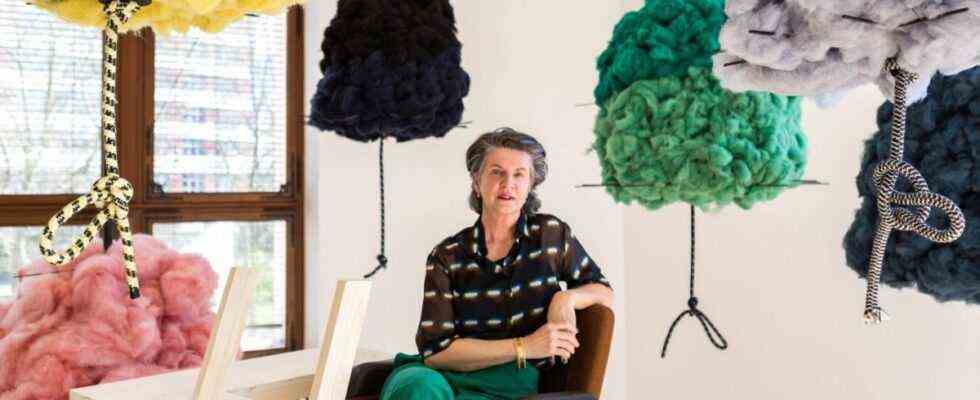The question couldn’t be more burning, especially these days: What to do with the balcony when it rains? The solution, as sustainable as it is elegant: simply fold it up. Hella Jongerius is not yet presenting fully usable folding balconies in the Gropius building in Berlin, but at least it is a preliminary stage. For her exhibition “Weaving Kosmos” she woven three-dimensional structures with photovoltaic strips or solar cells, which mostly hang limply on the wall, but also shine, move and stretch.
Balconies, says Jongerius, are just the beginning. During a tour of the Gropius-Bau she speaks of the automotive industry, of airplanes: “You could create sculptures that are so much more beautiful than these ugly solar roofs.” From the inconspicuous to the wondrous it is only one step in “Kosmos Weben”.
Dutch artist and designer Jongerius has worked in the industry for a long time, hoping to transform production from the inside. When this turned out to be hopeless in view of the inertia of those involved and the processes, she moved and looked for cultural platforms, museums, the Gropius building. Her exhibition can be seen there on the ground floor, while she works on the relationship between people and the world of things in her studio on the upper floor.
For Jongerius, the things with which we surround ourselves are “silent partners”
These namely, the objects that furnish the everyday life of mankind, are not neutral objects. For Jongerius – and Marie Kondo would be very close to her – they are “the silent partners” in houses and apartments. So far, unfortunately, according to the logic of consumption, they have only been celebrated when they are new and stylish, while they have so much more to give. When they get from one person to another as gifts, for example, or when they tell something about the process of their production, about tradition and culture, when they shine on their owner and become carriers of perception and identity, when they reveal what the owner is maybe even don’t know myself.
It doesn’t matter how an object is made, and it certainly doesn’t matter what it is made of. Jongerius melted the sand, which was used for another project in the atrium of the Gropius building, into ocean-colored glass bodies, vessels that no one will ever drink from, but which may contain other, more important things. “Materials are geopolitics,” says Jongerius. At best, objects can heal.
Visitors to the exhibition can “dance” a common thread
You have to get involved with this textile world, with the knots, webs and spindles. If you already get tension when approaching esotericism, you should go straight to the Gropius building Go to the dot universe of the Japanese artist Yayoi Kusama – if he catches a time slot. Jongerius invites the audience to use special braiding machines to “dance” a common thread, because weaving used to be such a sociable activity – anyone who knows Heine’s Silesian weavers has to rethink it. And she consulted shamans for advice on colors, shapes and cosmic cycles.
On the other hand, her art visualizes topics that are ancient and highly topical at the same time, and that’s refreshing. From blue, yellow or pink puffs hanging from the ceiling, she creates a thread that many cultures in ancient times spun in stories and legends before her, a thread that connects people with their lifetime, the earth and Heaven and the whole universe connects. Jongerius’ colorful wool clouds are made from former Italian upholstery fabric. Today’s Norns would recycle.
The yarn that connects everything with everything: Hella Jongerius, Spaceloom 2 (2021).
(Photo: Jongeriuslab)
However, the obvious interpretation of weaving is always a little too simple for Hella Jongerius. That everything is intertwined and interwoven, old and new, human and animal and cosmos, that seems to her to be a rather worn metaphor. But it is, she admits, that it is not wrong. “We stay alive because we are connected to everyone,” she says, although the benefits of this connection are very one-sided.
Jongerius has shown animals before, but seldom have they been as angry as they are here. Anyone who sees the heads of their snarling bears or of the howling gorilla suspects that human activity on earth does not go unnoticed, that the animals make a clear judgment about their exploitation and destruction. Only when this possibility is taken away from man – or when he gives it up – when the hierarchy of man, thing and nature has been overcome, only then is healing possible. It would be better to pick up the thread sooner rather than later.
Hella Jongerius: Weaving the Cosmos. Gropius-Bau Berlin, until August 15th.

